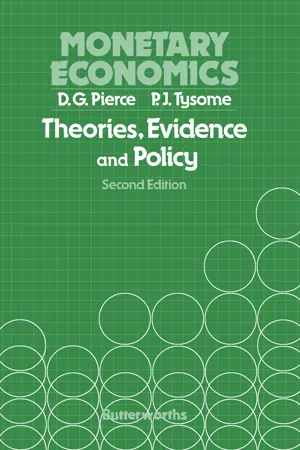
- 308 pages
- English
- PDF
- Available on iOS & Android
About this book
Monetary Economics: Theories, Evidence and Policy, Second Edition provides basic introduction to various aspects of monetary economics. The first chapter tackles the functions, advantages, and definitions of money. Chapter 2 deals with the monetary transmission mechanism. Chapter 3 discusses the demand for money, while Chapter 4 talks about the financial intermediaries and the supply of money. The book also covers the classical system and the neutrality of money. The Keynesian system and monetarism are then tackled. The text reviews the empirical evidence relating to the role of money. Other related topics covered are inflation; the balance of payments and the foreign exchange rate; and monetary policy. The book also deals with the techniques of monetary control. The last chapter discusses the U.K. post-WW2 monetary policy. The book will be of great interest to students and professionals involved in the study of monetary economics.
Frequently asked questions
- Essential is ideal for learners and professionals who enjoy exploring a wide range of subjects. Access the Essential Library with 800,000+ trusted titles and best-sellers across business, personal growth, and the humanities. Includes unlimited reading time and Standard Read Aloud voice.
- Complete: Perfect for advanced learners and researchers needing full, unrestricted access. Unlock 1.4M+ books across hundreds of subjects, including academic and specialized titles. The Complete Plan also includes advanced features like Premium Read Aloud and Research Assistant.
Please note we cannot support devices running on iOS 13 and Android 7 or earlier. Learn more about using the app.
Information
Table of contents
- Front Cover
- Monetary Economics: Theories, Evidence and Policy
- Copyright Page
- Table of Contents
- Dedication
- Preface
- Chapter 1. The functions, advantages and defínitions of money
- Chapter 2. Monetary transmission mechanisms and the channels of monetary influence
- Chapter 3. The demand for money
- Chapter 4. Financial intermediaries and the supply of money
- Chapter 5. The classical system and the neutrality of money
- Chapter 6. The Keynesian system
- Chapter 7. Monetarism
- Chapter 8. A review of the empirical evidence relating to the role of money and the effectiveness of monetary policy
- Chapter 9. Inflation
- Chapter 10. The balance of payments and the foreign exchange rate
- Chapter 11. Monetary policy: targets, indicators, rules and discretion
- Chapter 12. Techniques of monetary control
- Chapter 13. Monetary policy in the UK since the Second World War
- References
- Index